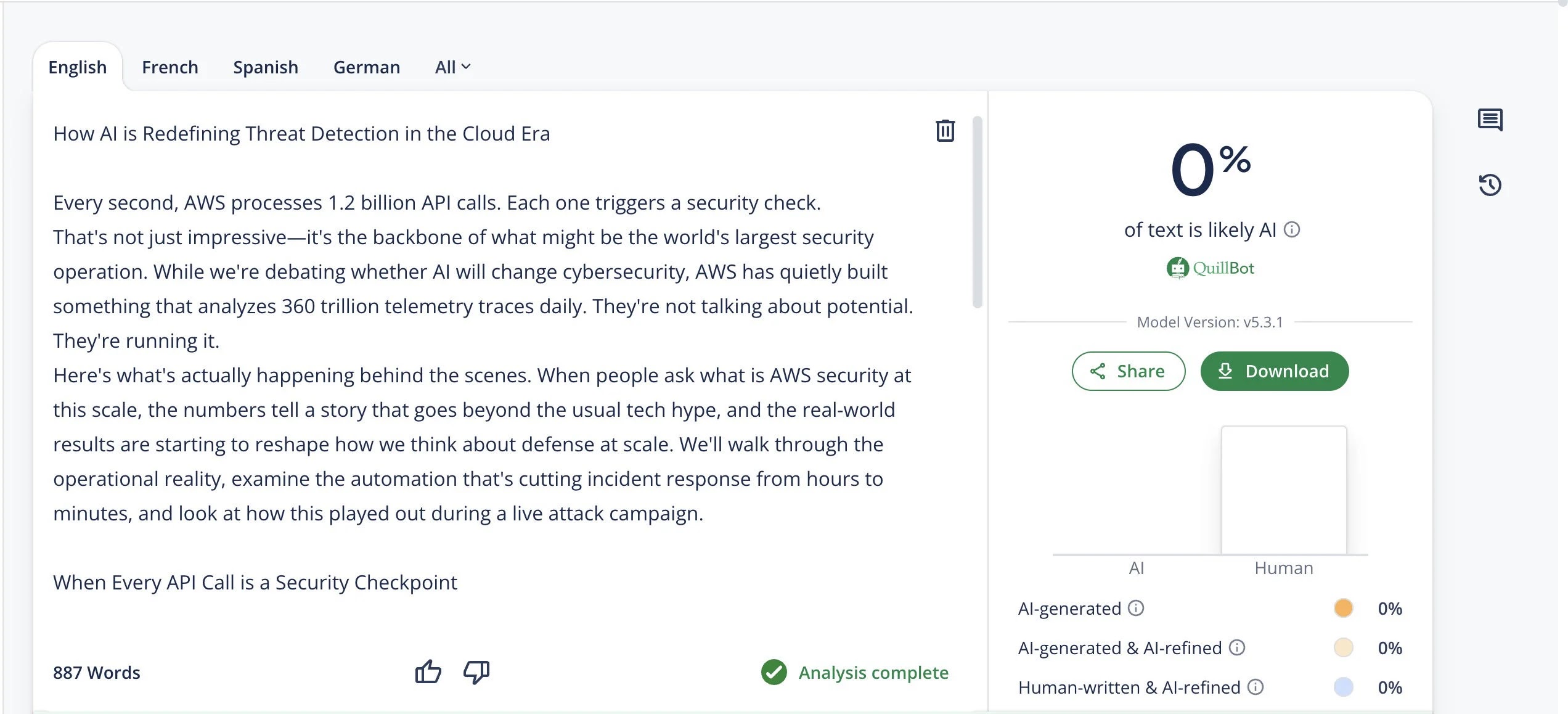Every second, AWS processes 1.2 billion API calls. Each one triggers a security check. That’s not just impressive it’s the backbone of what might be the world’s largest security operation.
While we’re debating whether AI will change cybersecurity, AWS has quietly built something that analyzes 360 trillion telemetry traces daily.
They’re not talking about potential. They’re running it. Here’s what’s actually happening behind the scenes.
When people ask what is AWS security at this scale, the numbers tell a story that goes beyond the usual tech hype, and the real-world results are starting to reshape how we think about defense at scale.
We’ll walk through the operational reality, examine the automation that’s cutting incident response from hours to minutes, and look at how this played out during a live attack campaign.
When Every API Call Is A Security Checkpoint
Think about your busiest day at work. Now multiply that by a trillion.
AWS’s security infrastructure doesn’t just handle volume it thrives on it. In the last six months alone, they blocked 2.4 trillion scanning requests.
That’s not a typo. We’re talking about threat detection that operates at a scale most of us can’t even conceptualize.
But here’s what makes this interesting. Each of those 1.2 billion API calls per second isn’t just processed it’s analyzed for fine-grained permissions.
The system checks who’s asking, what they’re asking for, and whether they should get it. Every single time.
The computational challenge is staggering. How do you analyze 360 trillion data points daily without creating bottlenecks? Traditional security monitoring would collapse under this load.
Even the most sophisticated human-driven security operations centers can’t operate at this velocity.
That’s where the story gets more compelling. AWS didn’t just scale up they fundamentally changed how security analysis works.
The AI Automation Achievement
Remember when security incident triage took most of your day? AWS cut that from 9.5 hours to minutes per log.
Not through wishful thinking or clever marketing. Through automation that actually works. Their AI-powered log analysis now delivers 50x productivity improvement, and we can see exactly how they did it.
Take new generative AI capabilities. Instead of parsing through endless log files, security teams get natural language summaries of what happened.
The AI identifies potential issues automatically and presents them in plain English. No more hunting through thousands of entries to find the needle.
Other platforms have learned to map attack sequences across multiple stages. It correlates events that might seem unrelated, building timeline views that reveal sophisticated multi-stage attacks.
In just 90 days, it identified 13,000 high-confidence attack sequences patterns that traditional monitoring might have missed entirely.
The practical impact? Security teams aren’t drowning in alerts anymore. AWS Security Hub now provides unified threat management across GuardDuty, IAM, Shield, and many other services.
Instead of juggling multiple dashboards, analysts get prioritized, actionable insights from a single interface.
But perhaps the most telling demonstration came during an actual attack campaign.
How AI Stopped A Live Encryption Attack Campaign
Here’s where theory meets reality.
AWS detected something unusual: threat actors were using valid credentials to re-encrypt S3 objects with server-side encryption using client-provided keys.
It’s a clever attack if you can’t steal the data, encrypt it with your own key and hold it for ransom.
Most security systems would struggle with this. The attackers had valid credentials. They weren’t technically breaking in.
They were just… encrypting things. Which looks legitimate until you realize what’s happening.
AWS’s AI-driven detection spotted the pattern. Not because someone programmed it to look for this specific attack, but because the system learned to recognize anomalous behavior across multiple data sources.
The timeline correlation capabilities revealed the attack sequence, even though individual actions appeared normal.
The response was swift. AWS deployed what they call “active defense tools” that prevented “a high percentage of attempts from succeeding”.
The key word there is “prevented” not just detected after the fact.
This capability is now baked into enhanced threat detection for Amazon EKS container environments. The system that learned to stop encryption attacks is expanding its reach.
Actually, there’s something worth noting here the speed of adaptation impresses me more than the initial detection.
The Defender’s Advantage In An AI-First Security World
We’re witnessing something that changes the fundamental equation in cybersecurity.
For decades, attackers held the advantage. They only needed to find one vulnerability, while defenders had to secure everything.
They could move fast and break things, while security teams were always playing catch-up.
But when you can analyze threats faster than attackers can evolve them, the game changes. AWS’s AI-driven defenses now operate at machine speed across data sets that exceed human comprehension.
While attackers still think in human timeframe planning campaigns over weeks or months these defenses adapt in real-time.
The broader context matters too. Organizations are now prioritizing generative AI as their top spending priority for 2025, with 45% of global IT leaders shifting budget allocation away from traditional cybersecurity.
But here’s the twist: the most effective AI implementations are happening within security operations themselves.
Consider this: what happens when your defensive capabilities exceed the attacker’s ability to innovate? When security systems can process more threat intelligence in a day than a human analyst could review in a lifetime?
We’re finding out. And the early results suggest that defenders might finally have the upper hand.

